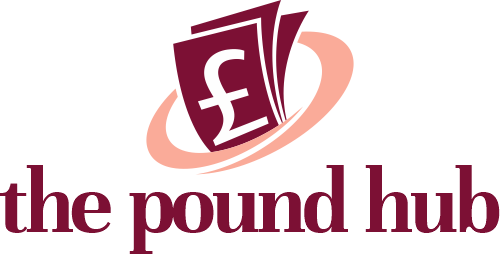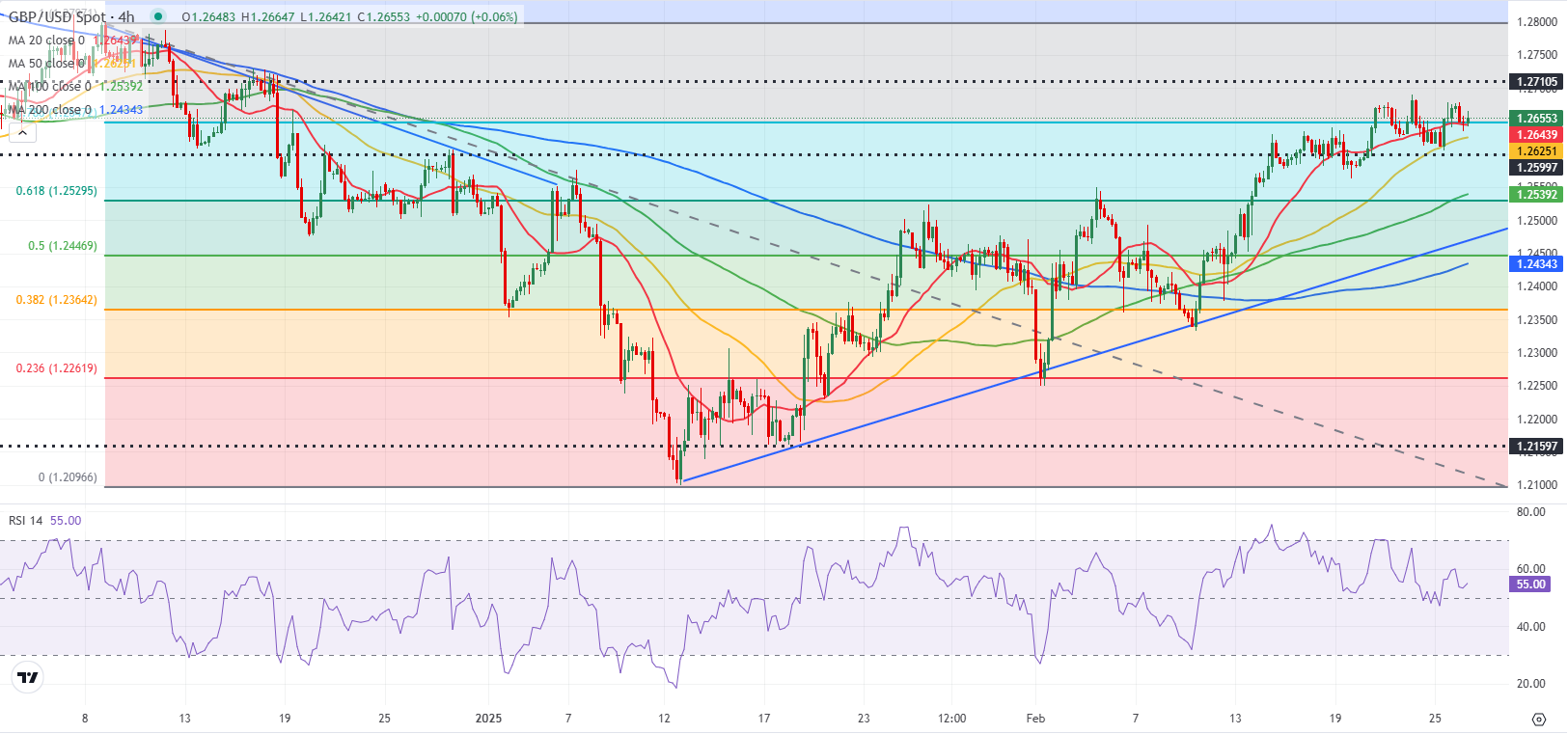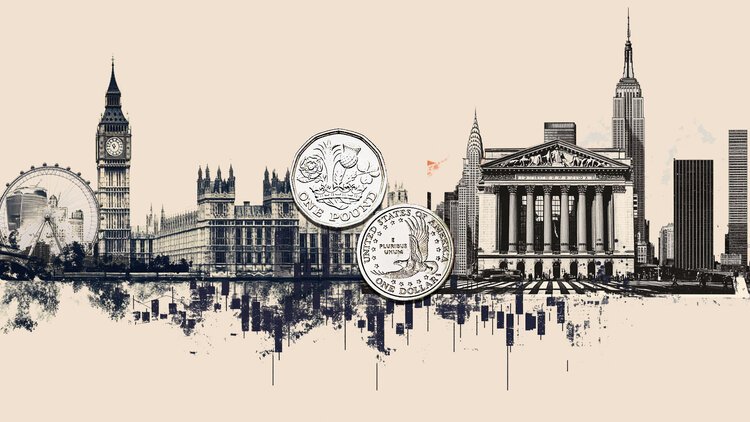- GBP/USD consolidates Tuesday’s gains, holds near 1.2650 early Wednesday.
- Technical buyers could remain interested if the pair confirms 1.2650 as support.
- The US economic calendar will not offer any high-impact data releases.
GBP/USD benefited from the selling pressure surrounding the US Dollar (USD) on Tuesday and ended the day in the positive territory. The pair stays in a consolidation phase near 1.2650 in the European session on Wednesday.
British Pound PRICE This week
The table below shows the percentage change of British Pound (GBP) against listed major currencies this week. British Pound was the strongest against the Canadian Dollar.
| USD | EUR | GBP | JPY | CAD | AUD | NZD | CHF | |
|---|---|---|---|---|---|---|---|---|
| USD | -0.33% | -0.20% | 0.07% | 0.79% | 0.48% | 0.60% | -0.34% | |
| EUR | 0.33% | 0.04% | 0.22% | 0.93% | 0.80% | 0.74% | -0.21% | |
| GBP | 0.20% | -0.04% | 0.25% | 0.89% | 0.76% | 0.70% | -0.25% | |
| JPY | -0.07% | -0.22% | -0.25% | 0.72% | 0.49% | 0.61% | -0.34% | |
| CAD | -0.79% | -0.93% | -0.89% | -0.72% | -0.36% | -0.19% | -1.13% | |
| AUD | -0.48% | -0.80% | -0.76% | -0.49% | 0.36% | -0.06% | -1.00% | |
| NZD | -0.60% | -0.74% | -0.70% | -0.61% | 0.19% | 0.06% | -0.94% | |
| CHF | 0.34% | 0.21% | 0.25% | 0.34% | 1.13% | 1.00% | 0.94% |
The heat map shows percentage changes of major currencies against each other. The base currency is picked from the left column, while the quote currency is picked from the top row. For example, if you pick the British Pound from the left column and move along the horizontal line to the US Dollar, the percentage change displayed in the box will represent GBP (base)/USD (quote).
The USD weakened against its major rivals in the American session on Tuesday as the benchmark 10-year US Treasury bond yield dropped to its lowest level in over two months below 4.3%. US Treasury Secretary Scott Bessent reiterated that US President Donald Trump’s administration aims to reduce spending, while easing monetary policy and lowering Treasury yields at the same time.
Meanwhile, Trump’s trade adviser, Peter Navarro, told CNBC on Tuesday that tariff negotiations with Canada and Mexico were ongoing and added that they are planning to set a reciprocal tariff for digital services tax.
In the early American session, Trump is scheduled to hold a press conference. In the absence of high-impact data releases, market participants will pay close attention to the action in the US bond and stock markets. At the time of press, US stock index futures were up between 0.3% and 0.8%, while the 10-year US T-bond yield was holding steady slightly above 4.3%.
In case Wall Street’s main indexes keep the bullish tone after the opening bell, GBP/USD could gain traction. If, however, US yields extend the rebound, the pair’s upside could remain capped.
GBP/USD Technical Analysis
The Relative Strength Index (RSI) indicator on the 4-hour chart holds above 50, suggesting that sellers struggle to take control of the pair’s action.
The 100-day Simple Moving Average (SMA) aligns as a pivot level at 1.2650. Once GBP/USD makes a daily close above this level and starts using it as support, technical buyers could remain interested. In this scenario, 1.2700-1.2710 (round level, static level) and 1.2750 (static level) could be seen as next resistance levels.
On the downside, supports could be spotted at 1.2600 (static level, round level), 1.2540 (100-period SMA on the 4-hour chart, Fibonacci 61.8% retracement of the latest downtrend) and 1.2500 (round level, static level).
Pound Sterling FAQs
The Pound Sterling (GBP) is the oldest currency in the world (886 AD) and the official currency of the United Kingdom. It is the fourth most traded unit for foreign exchange (FX) in the world, accounting for 12% of all transactions, averaging $630 billion a day, according to 2022 data. Its key trading pairs are GBP/USD, also known as ‘Cable’, which accounts for 11% of FX, GBP/JPY, or the ‘Dragon’ as it is known by traders (3%), and EUR/GBP (2%). The Pound Sterling is issued by the Bank of England (BoE).
The single most important factor influencing the value of the Pound Sterling is monetary policy decided by the Bank of England. The BoE bases its decisions on whether it has achieved its primary goal of “price stability” – a steady inflation rate of around 2%. Its primary tool for achieving this is the adjustment of interest rates. When inflation is too high, the BoE will try to rein it in by raising interest rates, making it more expensive for people and businesses to access credit. This is generally positive for GBP, as higher interest rates make the UK a more attractive place for global investors to park their money. When inflation falls too low it is a sign economic growth is slowing. In this scenario, the BoE will consider lowering interest rates to cheapen credit so businesses will borrow more to invest in growth-generating projects.
Data releases gauge the health of the economy and can impact the value of the Pound Sterling. Indicators such as GDP, Manufacturing and Services PMIs, and employment can all influence the direction of the GBP. A strong economy is good for Sterling. Not only does it attract more foreign investment but it may encourage the BoE to put up interest rates, which will directly strengthen GBP. Otherwise, if economic data is weak, the Pound Sterling is likely to fall.
Another significant data release for the Pound Sterling is the Trade Balance. This indicator measures the difference between what a country earns from its exports and what it spends on imports over a given period. If a country produces highly sought-after exports, its currency will benefit purely from the extra demand created from foreign buyers seeking to purchase these goods. Therefore, a positive net Trade Balance strengthens a currency and vice versa for a negative balance.








